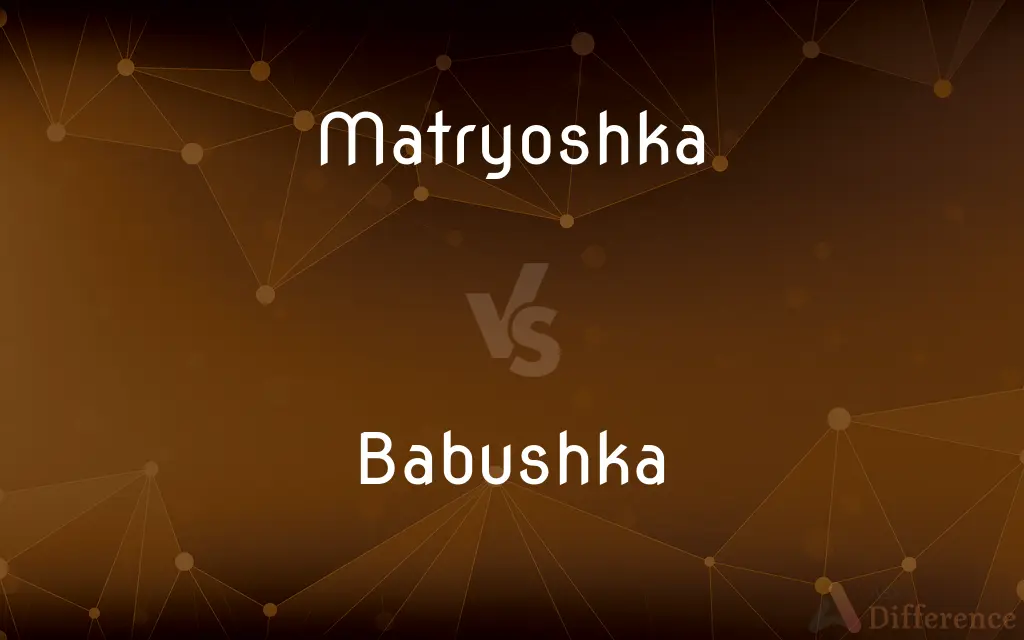Matryoshka vs. Babushka — What's the Difference?
By Tayyaba Rehman — Updated on November 3, 2023
Matryoshka dolls are traditional Russian nesting dolls, while babushka can refer to a headscarf or an elderly Russian woman.

Difference Between Matryoshka and Babushka
Table of Contents
ADVERTISEMENT
Key Differences
Matryoshka dolls are a well-known Russian souvenir, representing a set of wooden dolls of decreasing size placed one inside the other. Each Matryoshka splits in half at the midsection to reveal another, smaller doll within. The term "Babushka," on the other hand, holds dual meanings in Russian culture: it can refer to a grandmother or an elderly woman, and it also describes a traditional headscarf tied under the chin, typical among the older generation.
The artistry behind a Matryoshka is often intricate, showcasing traditional Russian attire and folklore themes on the dolls' exteriors. Babushkas, the headscarves, similarly display a variety of patterns and colors, reflecting the wearer's taste or regional designs. Neither should be confused with one another despite sharing cultural roots, as a Matryoshka is a craft object while a Babushka as attire serves a practical purpose.
One might find a Matryoshka as a decorative piece in homes or as a collectible, symbolizing Russian culture and heritage. A Babushka, when referring to a person, is associated with the image of a wise, older woman who often plays a central role in family life, drawing on the deep-seated respect for elders in Russian society. The headscarf known as a Babushka is emblematic of modesty and a connection to traditional values.
The popularity of Matryoshka dolls has spread globally, and they have become an icon of Russia abroad. Conversely, Babushka, when used to describe an elderly woman, may carry different connotations outside of Russia, sometimes used endearingly or humorously in Western contexts. The headscarf Babushka remains distinctive to Eastern European attire, less known internationally but still recognized within the context of Russian culture.
Matryoshka dolls are often handmade, a detail that showcases the skill and tradition of Russian artisans. Babushkas, whether women or scarves, are similarly steeped in traditions of care, nurturing, and practicality. Both terms, while distinct in their meanings, paint a picture of Russian heritage, yet one represents a cultural artifact and the other, aspects of personal identity or fashion.
ADVERTISEMENT
Comparison Chart
Literal Meaning
Russian nesting dolls.
Grandmother or headscarf.
Cultural Symbolism
Represents Russian artistry and folklore.
Symbolizes wisdom, age, or traditional fashion.
Usage in Language
Singular and plural noun.
Noun with dual meanings.
Material Composition
Typically made of wood.
Fabric for the scarf; metaphorical for a person.
Function
Decorative and collectible item.
Scarf for warmth and modesty; familial term for a woman.
Compare with Definitions
Matryoshka
Symbolic representation of the Russian babushka or mother figure in doll form.
The Matryoshka’s outermost doll wore a traditional babushka scarf.
Babushka
A Russian word for grandmother.
My Babushka shared stories of her childhood in Russia.
Matryoshka
Traditional Russian nesting dolls.
She bought a hand-painted Matryoshka set from the Moscow market.
Babushka
Sometimes used colloquially to refer to any headscarf worn in a similar style to that of Russian tradition.
She wrapped a babushka around her head before stepping out into the frosty morning.
Matryoshka
Collectible art form with roots in Russian folk culture.
Her collection of Matryoshkas varied in size and design, showcasing different Russian art styles.
Babushka
A headscarf, typically tied under the chin, traditional among elderly Eastern European women.
She wore a floral babushka to protect her hair from the wind.
Matryoshka
A set of dolls of decreasing sizes placed one inside another.
The largest Matryoshka held six smaller dolls inside it.
Babushka
A cultural icon symbolizing wisdom and matronly virtue.
In our family, the babushka is the most revered member.
Matryoshka
Wooden figurines that open to reveal another figure of the same sort inside, continuing sequentially.
Each Matryoshka revealed another, each more intricately painted than the last.
Babushka
(in Russia) an old woman or grandmother.
Matryoshka
Another term for Russian doll
Babushka
A headscarf, folded triangularly and tied under the chin, traditionally worn by women in eastern Europe.
Matryoshka
A nesting doll that is part of a set and is decorated with the features of a woman in traditional Russian dress.
Babushka
An elderly Russian or Polish woman, especially one who is a grandmother.
Babushka
An old woman, especially one of Eastern European descent.
Babushka
(By association) A stereotypical, Eastern European peasant grandmother-type figure.
Babushka
An old woman of Russian or Belarusian descent with unwelcome conservative and/or Orthodox Christian views.
Babushka
A traditional floral headscarf worn by an Eastern European woman, tied under the chin.
Babushka
Russian doll, matryoshka
Babushka
A woman's headscarf folded into a triangle and tied under the chine; worn by Russian peasant women
Babushka
An affectionate term for an older woman.
The kind babushka at the market helped me pick the best vegetables.
Common Curiosities
What is a Matryoshka?
A Matryoshka is a set of Russian nesting dolls made of wood, with each doll fitting inside the next larger one.
Are Matryoshkas used for anything besides decoration?
Matryoshkas are primarily decorative but can also be educational toys or collectibles.
Can the term Babushka refer to an object?
Yes, Babushka can refer to a traditional headscarf worn by women.
Are Matryoshkas painted by hand?
Traditionally, Matryoshkas are hand-painted, though some modern versions may not be.
Can Babushka be used to address any elderly woman?
It can be, but it is more appropriate to use it when there is a familiar or cultural context.
What's inside the smallest Matryoshka?
The smallest Matryoshka is typically a solid piece of wood, too small to open.
Do all Babushkas wear the headscarf known as a Babushka?
No, not all elderly women (Babushkas) wear the headscarf, though it is traditional.
Do Matryoshka dolls have a symbolic meaning?
Yes, they often symbolize fertility, motherhood, and the continuity of life.
What does the largest Matryoshka doll represent?
The largest Matryoshka typically represents the matriarch or the starting figure of the set.
How many dolls are in a typical Matryoshka set?
A typical Matryoshka set can have anywhere from 5 to 20 dolls, though sets with 5 to 10 dolls are most common.
Is Babushka a term of endearment?
Yes, calling someone Babushka can be a term of endearment, signifying respect.
Are Matryoshkas always female figures?
Traditionally, yes, but modern Matryoshkas can depict animals, fictional characters, or even political figures.
Can men wear a Babushka?
The term is gender-specific to women, but men might wear similar headscarves for warmth, not typically called Babushka.
Does Babushka have a specific style or pattern?
No, Babushka scarves can come in many styles, colors, and patterns, though floral designs are traditional.
Are Babushka scarves worn for religious reasons?
In some cultures, yes, they can signify modesty or religious observance.
Share Your Discovery

Previous Comparison
Insecticide vs. Pesticide
Next Comparison
Trust vs. MistrustAuthor Spotlight
Written by
Tayyaba RehmanTayyaba Rehman is a distinguished writer, currently serving as a primary contributor to askdifference.com. As a researcher in semantics and etymology, Tayyaba's passion for the complexity of languages and their distinctions has found a perfect home on the platform. Tayyaba delves into the intricacies of language, distinguishing between commonly confused words and phrases, thereby providing clarity for readers worldwide.
















































